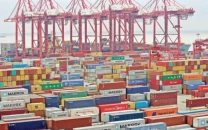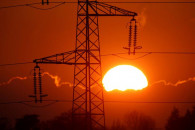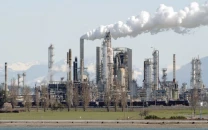When public debt does not translate to economic growth
Economic growth has not matched debt growth, but gap has narrowed

Economic growth has not matched debt growth, but gap has narrowed. PHOTO: REUTERS
While the current debate on public debt is narrowly and wrongly focused on the stock of debt, and one can cite several countries at much higher debt-to-GDP ratio, there are some important indicators that are often missed out.
Former central bank governor Dr Ishrat Husain presented at a recent national debt conference, “we should not worry as long as economic growth is leading the debt growth”, which constitutes the first important indicator. The other indicator is debt-servicing capacity.
Conventional understanding is that if the economic growth is higher than the debt growth, then the debt utilisation is productive.
The other important metric is that if the debt-servicing outlay is less than 30% of the total federal outlays, it is considered sustainable. Within debt servicing, another indicator is the external debt servicing/export earnings.
SBP’s profit rises 4% to Rs238b, driven by lending to govt, banks
According to the latest data released by the State Bank of Pakistan (SBP), public debt grew by 8.7% in 2014-15, 14% in 2015-16 while the economy grew by 6%; and 11.3% in 2016-17 when the economic growth was 9.48%.
While these growth numbers may be astonishing, they are based on the revised SBP estimates based on current market prices. This comparison leads to a clear conclusion – the economic growth has not matched the debt growth, though the gap has narrowed down.
Over the last three years, the external debt servicing/export earnings has deteriorated from 18.1% to 29.9%. This is obviously due to the decline in exports.
On the other hand, the government seems to have improved the overall debt-servicing capacity, by keeping this narrowly below 30% of the budget in 2017-18, though one hopes that actual expenditures do not deviate too much from the budgeted ones. It is a considerable improvement over the previous ratios of 40-45%.
Based on these three indicators, the government has exhibited mixed record on public debt. While the economic growth has picked up, one can be optimistic about surpassing the debt growth in the future.
However, to achieve this possible target, the government must exercise restraint not only on non-productive expenditures but also restrain its demand for debt, especially from domestic sources.
Domestic vs external financing
One commonly hears that domestic borrowing is preferred over external financing as the latter is subject to exchange rate fluctuations. While exchange rate fluctuations can be managed through defining debt contracts wisely, the domestic debt is more risky.
Government borrowing crowds out private sector lending, which is the engine of growth. When you take out capital from this engine of growth, it stops growing, thus affecting the overall capacity of debt repayment.
Pakistan’s domestic sector needs a heavy stimulus, not in the form of bailouts and subsidies, but in the form of investment and credit flows. What is worrisome is that in 2016-17, the government estimated Rs453 billion as bank borrowing but ended up borrowing Rs741 billion.
In 2015, at a national debt conference, leading economist Dr Hafiz Pasha had projected that Pakistan’s external debt would touch $90 billion in four years. Although the federal finance minister arrogantly dismissed the projection, and published his rejoinders, the latest number released by the SBP indicates that in just two years after that speech, the external debt has crossed $83 billion.
Pasha was actually optimistic when he said four years. As an organiser of that conference, I was approached by a diplomat some weeks later, who listened to that speech, did his own calculation and endorsed Pasha’s estimates, as the economist had not shared the model publicly and only released the results. Now Pasha is projecting that the country will again need to approach the IMF in 2018 on account of surging balance of payments deficit. Let’s hope that he is not proven right again!
Govt coins new term for public debt
Productive investment
What are the consequences of increasing levels of debt for the country’s economic future? Can we borrow our way to economic growth?
As an economist “on the other hand”, I would say it is possible. However, it all depends on how much of debt can be propelled into productive investment. We borrowed to build Tarbela and Mangla Dams and there cannot be two opinions about the crucial role these two projects have played in agricultural transformation and industrial productivity over the last 40 years.
Are we investing current capital, especially when borrowed, wisely enough? As a country ranked at No 147 in doing business, the answer is not very optimistic.
The writer is the founder of PRIME Institute, an independent economic policy think tank based in Islamabad
Published in The Express Tribune, November 6th, 2017.
Like Business on Facebook, follow @TribuneBiz on Twitter to stay informed and join in the conversation.



















COMMENTS
Comments are moderated and generally will be posted if they are on-topic and not abusive.
For more information, please see our Comments FAQ